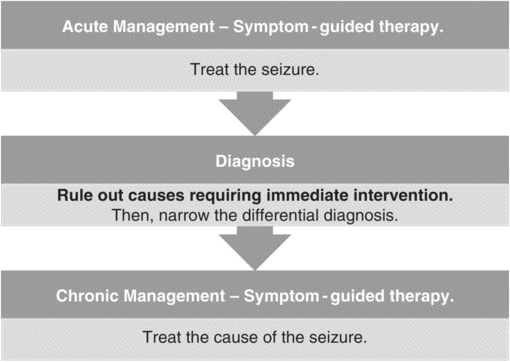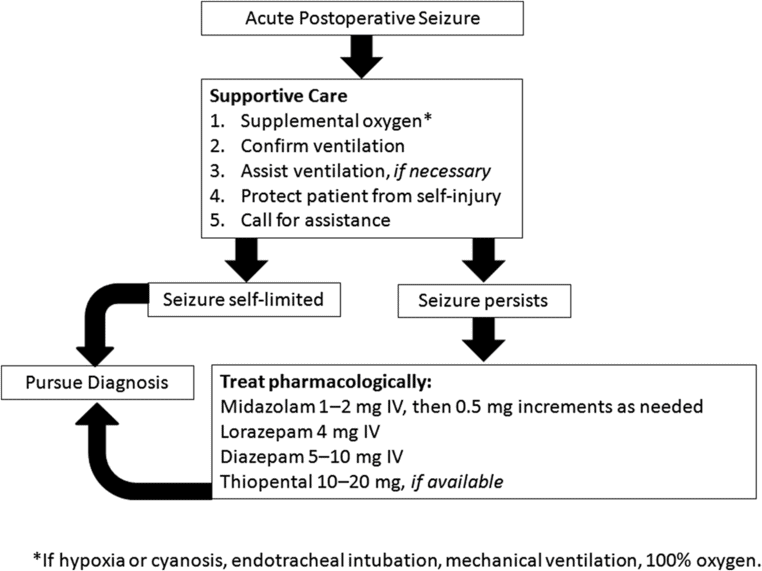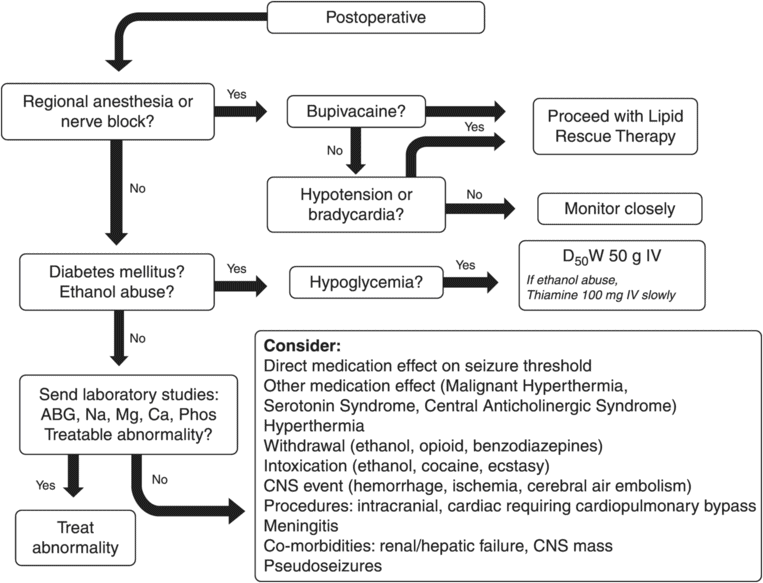Myoclonus is common in surgical patients and in extreme form can appear like convulsions. Perioperative medications, such as metoclopramide, can trigger extrapyramidal symptoms and include oculogyric crisis (involuntary upward rotation of the eyes), dystonia (muscle spasms), torticollis (involuntary lateral neck flexion), and rarely tardive dyskinesia (involuntary repetitive movements).[1] Vigorous shivering or rigors may resemble convulsions. Possible seizure activity is usually observed in the perioperative setting without electroencephalographic (EEG) confirmation, further hindering the certainty of diagnosis.
Management
Although heterogeneous in presentation and etiology, postoperative seizures may be effectively managed in similar fashion (see Figure 25.2). The first step is symptom-guided therapy to treat the seizure. Once acutely managed, the second step is to determine the cause of the seizure. Etiologies requiring immediate intervention (hypoxia, hypoglycemia, local anesthetic toxicity [LAST]) need to be excluded first, then the broad differential can be systematically explored. Laboratory studies or radiographic imaging may aid the diagnosis. When the etiology is determined, the third step is to provide diagnosis-guided therapy.
The acute management of all postoperative seizures is initially supportive (Figure 25.3). Ensure ventilation, provide supplemental oxygen, and protect the patient from self-injury during the event. With the absence of a structural lesion of the central nervous system (CNS), the majority of postoperative seizures are brief and self-limited. However, if needed, benzodiazepines or barbiturates will usually terminate a seizure with administration of low doses. After the seizure has been successfully controlled, hypoxia, LAST, and hypoglycemia need to be considered and immediately addressed if present (Figure 25.4).
Hypoxia needs to be immediately excluded as a cause for postoperative seizure. In the early postoperative period, any CNS symptom (confusion, agitation, delirium, seizure) should be treated as hypoxia until proven otherwise. If low oxygen saturation is noted by pulse oximetry or central cyanosis is observed, endotracheal intubation and mechanical ventilation with 100% oxygen should be initiated.
LAST needs to be considered for any perioperative patient, especially if a nerve block or regional anesthesia has been performed. Local anesthetics cause neurological and cardiac toxicity, but the plasma levels for cardiac toxicity are generally two fold to four fold higher than needed for seizure. Most patients with LAST presenting with convulsions require only supportive care. Bupivacaine is an important exception and the plasma level of bupivacaine needed to provoke asystole is similar to the level to provoke seizure. If a seizure is caused by bupivacaine, cardiac arrest may be impending. Respiratory acidosis and hypoxia worsens LAST, so ventilation should be supported if necessary. If bupivacaine has been administered or cardiac symptoms (bradycardia, hypotension) are present with LAST from any type, lipid rescue should be implemented without delay.[2] Multiple case reports and reviews have been published showing survival of patients after lipid therapy for LAST.[3–9] Cardiovascular collapse may be the FIRST sign of bupivacaine toxicity in 40% of cases and may be delayed up to an hour after injection.[10]
2. Seizure suppression. Administer midazolam 1–2 mg IV or another benzodiazepine.
3. Bolus 1.5 ml/kg lean body mass 20% lipid emulsion over 1 minute.
4. Start infusion 0.25 ml/kg/min.
5. Repeat bolus 1–2× for continued cardiovascular collapse.
6. Double the infusion rate to 0.5 ml/kg/min if patient remains hypotensive.
Additional information may be found at http://www.lipidrescue.org/
7. Continue infusion for 10 minutes beyond establishing normal circulation.
8. Upper limit = 10 ml/kg in first 30 minutes.
A blood glucose measurement should be rapidly obtained for any patient with a new-onset postoperative seizure, but is of particular importance for patients with diabetes mellitus, chronic ethanol abuse, or malnutrition. Hypoglycemia and seizure is a medical emergency and if present should be treated with D50W 50 g IV.
If the etiology of the seizure has not been identified, an arterial blood gas and electrolytes including sodium, magnesium, calcium, and phosphate should be obtained. Abnormalities detected should be appropriately treated. If the patient is on anticonvulsant medications for epilepsy, blood should also be obtained for therapeutic level monitoring, if applicable. Serum levels of anticonvulsants are not always obtained preoperatively, since many patients may have seizures controlled with “sub-therapeutic” plasma levels. However, a sub-therapeutic level of an antiepileptic medication should be increased if seizures occur.
The etiology of postoperative seizure is broad. Seizures are common after intracranial procedures and cardiopulmonary bypass. Seizures after neurological surgery are often persistent and require anticonvulsant therapy. The perioperative period is a time of polypharmacy, and if LAST has been eliminated as the cause of the convulsion, other medication effects need to be considered.
Medication effects
Many anesthetic medications may display both proconvulsive and anticonvulsive activity (Table 25.1).[11,12] This seemingly paradoxical clinical observation is attributable to the crucial importance of context and dosing. In low doses, some medications may cause CNS excitation and seizure, but at higher doses cause CNS depression and abort seizures. This phenomenon explains the clinical adage, “Wrong drug and not enough of it!” In some instances, administering more of the medication that provoked the seizure will also terminate it.
| Amoxapine |
| Chlorpromazine |
| Clozapine |
| Maprotiline |
| Clomipramine |
| Bupropion |
| Venlafaxine |
| Meperidine |
| Flumazenil |
| Theophylline |
| Isoniazid |
| Alkylating antineoplastic agents (etoposide, ifosfamide, cisplatin) |
| Cyclosporine |
| Penicillin |
| Cephalosporins |
| Imipenem |
| Fluoroquinolones |
| Cocaine |
| Amphetamines |
| Hallucinogens |
| Local anesthetics |
| Withdrawal from: |
| Barbiturates |
| Benzodiazepines |
| Baclofen |
| Meprobamate |
| Chloral hydrate |
| Zolpidem |
| Narcotics |
| Anticonvulsants |
| Alcohol |
Induction agents: Intravenous agents for the induction of general anesthesia are a pharmacologically diverse group of medications with differing seizure effects. Many medications may be utilized to induce general anesthesia, but only five are in common clinical use for this purpose: thiopental, methohexital, etomidate, ketamine, and propofol. Barbiturates typically display strong anticonvulsant activity at clinical doses. Thiopental is a barbiturate that has strong anticonvulsive properties, but is not commercially available in the United States at this time. Methohexital is a unique barbiturate since it possesses proconvulsive properties. Methohexital administration has been associated with seizures in patients with prior epilepsy and among patients without prior seizure activity.[13]
Etomidate is an imidazole derivative with marked proconvulsive properties. Seizures from etomidate administration have been reported in epileptics and non-epileptic patients.[14,15] Ketamine is an N-methyl-D-aspartate (NMDA) receptor antagonist. While ketamine is frequently cited in anesthesia texts as being proconvulsant, scant evidence supports this assertion. Ketamine administered in combination with IV aminophylline, both bronchodilators once co-administered during anesthesia to asthmatic patients, was reported to cause seizure activity. Ketamine as a single agent is rarely implicated in provoking seizures even among epileptic patients. Moreover, ketamine administration may successfully terminate status epilepticus[16] and has been used by intramuscular administration to abort seizures in pediatric patients without IV access.[17,18]
Propofol (2,6-diisopropylphenol) is a non-barbiturate induction agent in widespread clinical use. The effect of propofol administration on seizure threshold is controversial. Propofol was introduced into clinical usage with the assumption that it had no significant pro- or anticonvulsant properties.[19] However, its anticonvulsant effects soon became apparent. Propofol reduces the seizure duration during electroconvulsive therapy by 63% compared with the strongly anticonvulsant thiopental[20] and appears to reduce duration without raising the seizure threshold.[21] There are numerous reports of propofol terminating seizures of status epilepticus. Conversely, there are also numerous reports of propofol inducing seizure activity in patients with and without prior epilepsy. Most of these have been observed during emergence from anesthesia, but some have occurred in the postoperative period.[22] There is some controversy over whether these are observations of myoclonus or true seizure. Although propofol is commonly administered to epileptic patients in the United States, the Committee on Safety of Medications in the United Kingdom and the Australian Adverse Drug Reactions Advisory Committee have both issued warnings about the use of propofol in epileptic patients.[23,24] In one small study of slowly titrated (0.5 mg/kg increments) propofol induction with EEG monitoring, spike wave activity was increased at levels below 2 mg/kg, then decreased at levels surpassing this dose.[25] One patient with a history of epileptic seizure experienced a seizure at 1 mg/kg of propofol which was terminated by administration of another 0.5 mg/kg. This suggests the propofol may display both pro- and anticonvulsant properties depending upon the dose administered.
Opioids: Mu-receptor agonists may induce seizures,[26] but few do so at clinically relevant doses. Alfentanil, sulfentanil, fentanyl, remifentanil, morphine, and hydromorphone have all been rarely reported in causing seizure activity. Meperidine is metabolized to normeperidine, which has renal elimination and has been often observed to cause seizure when plasma levels accumulate in patients with renal insufficiency. With adequate renal function, meperidine is not associated with seizures at therapeutic dosing even among individuals with established epilepsy.[27]
Nitrous oxide: Nitrous oxide has been associated with seizures in mice, but has not been reported to cause seizures in humans when used in modern anesthetic practice. The historical practice of 100% nitrous oxide inductions was reported to cause seizure-like activity associated with cyanosis, and these were almost certainly hypoxia-induced seizures. Similarly, nitrous oxide can also induce seizure activity when administered under hyperbaric conditions.[28]
Volatile agents: Enflurane was frequently observed to cause seizures when administered in high concentrations, but this agent is no longer in clinical use in the United States. Sevoflurane has been reported to cause seizures at clinical doses[29–31] and there is some EEG evidence that these are true seizures.[32,33]
Neuromuscular blockers (NMB): NMB are administered during most general anesthetics and will block the motor activity associated with tonic-clonic seizure, but not the seizure. Atracurium is metabolized to laudanosine, which has been associated with seizures in animal models. Prolonged continuous infusion of atracurium during postoperative mechanical ventilation has been associated with serum levels sufficient to cause seizures in animal models, but seizures in humans have not been reported.[27]
Other significant medication effects would include syndromes that include seizures, including malignant hyperthermia, serotonin syndrome, and central anticholinergic syndrome, but seizure would seldom be the first sign of any of these.
Alcohol withdrawal syndrome (delirium tremens) should be considered for any patient presenting with postoperative seizure. Alcohol withdrawal syndrome presents with fever, sweating, tachycardia, tremor, CNS manifestations (confusion, hallucinations), agitation, and seizures. General anesthesia may mask the early signs, and seizure may be the first recognized sign in the early postoperative period. Unhealthy alcohol use is common, but patients presenting for surgeries for head and neck cancers are at increased risk. Treatment is with benzodiazepines. Oxazepam or lorazepam may be preferred in patients with concurrent liver disease.
Pseudoseizures may occasionally be observed in the early postoperative period.[34,35]
Stay updated, free articles. Join our Telegram channel

Full access? Get Clinical Tree







